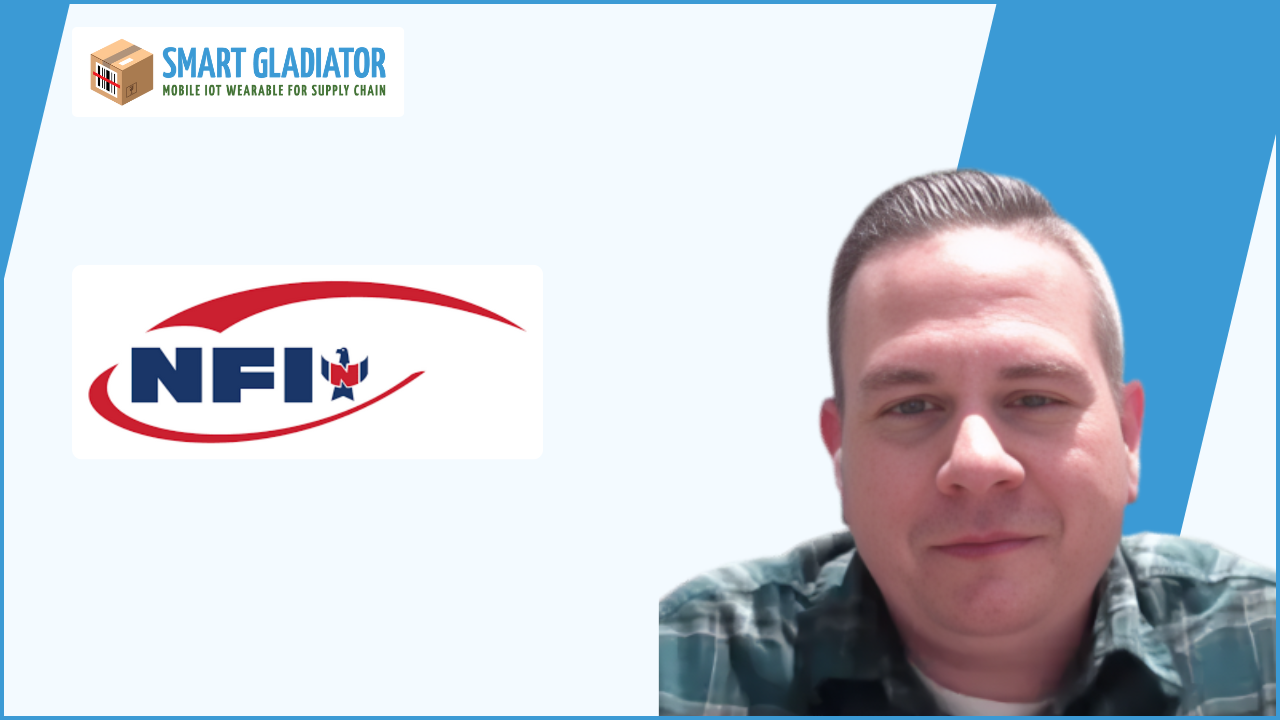proof and how we use it on a daily basis has dramatically decreased our um damage rate yep especially on inbound okay so we we start putting pressure on the mills for kimberly clark are like now a lot more aware oh yeah okay so with it before with just taking a picture on your cell phone and and then hopefully remembering it later yep um having everything in one little little website database however you want to call it um helps us out a lot having everything in one place having the description having a carrier having a trailer number having the reason why like the reason when we open the trailer door yep to have it real time on that and being able to look at it later instead of trying to remember it later it has helped us out astronomically right yeah.
um so we have we’ve been like I said we’ve been pushing back on the mills sending us things um it going against our own damage rate so we’ve been pushing it back um on them they’ve been making it a heck of a lot better with um inbounds for us and we’ve also we’ve also started implementing the outbound process so right there’s a there’s a couple really high profile customers like walmart and target yep um we have a few other ones like wegmans uh whole foods yup that do take um our our our pictures and the information that we have so we can send them okay this is how it how it was sent from our warehouse yep this is a carrier responsibility now yeah it’s no longer on the warehouse it’s on the carrier.
um and we show them how we loaded it uh with within the layers of the stacks in the truck yep um and we can take that back to the customer so it helps us on the inbounds and helps so many outbounds and it helps us log it into a a program called sap for us um to where we can send it to kimberly clark and say okay this is where we went with the outbound this is this is the carrier issue now this is where we went with an inbound this is a mill issue it’s not necessarily our issue anymore as an nfi putting out the work or bringing in the work right yeah.
so it yeah like I said it’s helped us out tremendously and um we haven’t done too many changes within the program with what we need to see and what we need to input yep um but we have we’ve kept it the same because it’s been working yeah um I I don’t I don’t see a need for any changes on our part as of right now but it it’s it’s yeah it’s really it’s really really really really helped us out great.
so couple of questions right on the inbound side I mean I’ll be you know a candid here we have your competitor that we are supporting as well right 23 sites you know they’re using it and and they are telling the same thing and hey you know this is a great feedback for the manufacturing plans and also there are some carriers and these guys you know because the roles are so big you know they use some rail carriers and that are you know um bringing the big roles and there are some damages that happen along with the you know and you know how it is right I mean we don’t have like thousands of rail carriers you know like we have the you know truckers so.
and region wise there is only one and they kind of do whatever they want so now you know with photos they’re able to so is that from an inbound perspective is that feedback to the manufacturing plant or is it to the carriers you know or do you guys have any rail carriers is there any specific you know damages that are happening you know that’s that’s you know quite unique for those rail carriers so it’s it’s more about accountability as at this point right got it.
so if we’re we’re taking pictures immediately opening up the door and showing what we see right yep that gives them the information it goes back to the carrier and then the carrier gets it and then it goes back to the mill so it’s it’s a lot of different steps but it’s holding everybody accountable accountable yeah so the mills holding the the carrier that is accountable we are holding the carrier caliber so yeah it’s definitely helping us out there great great great.
so from an outbound perspective you mentioned uh you know obviously right I mean the retailers you know um they have I mean they are trying to you know expense their labor cost right that’s the whole point of charge max and you know they got to put it somewhere and they throw it back to the suppliers so is that just the you know shipping uh is that the standard you know shipping to the retail scenario I know um nfi also runs some deconsolidation and consolidation um you know sites for these retailers right or is it part of that it’s part of that okay okay okay okay yeah.
so and then it’s the whole accountability piece as well so if we’re shipping out something that is almost pristine like a white glove exactly um it’s type of shipment and it’s going to the carrier once it leaves our site we show them this is how it’s this is how it’s being sent and it should be it should be handled that way exactly we’ve also we’ve also started using it with our ltls as well yeah um so it’ll go to a hub and then those stacks will get split up into so we’ve been using that as well.
because when when the carrier gets to the hub and they see that the whole shipment has been shifted well then we go back and say okay well we sent it like this we have we have the entire uh the entire all the pictures all the information this isn’t us okay so it’s really held not not just ourselves accountable but the amount of the the let the less amount of work that we have to do in the long run than it is just trying to remember things now we’re documenting yep and moving forward with it it’s it’s it’s really exactly you record a great point um you know basically we hear this all the time.
Hey, now this is an extra step that I have to do in the outbound process, but in the long run, that time is very less. You guys are taking only five minutes; we have customers reporting that we are spending only five minutes. It looks like it might take a lot of time, but it’s just a few seconds for a pallet, and it’s five minutes per truck, container, whatsoever. When there’s a query or a problem, this system is so useful. We aren’t spending hours looking for photos. I’ve used applications like this before and have been hesitant in the past. With LoadProof, it doesn’t time out; I can take as many pictures as I want, up to about 50. I can document everything going out or coming in easily.
In other applications, if I took two or three pictures and put the tablet down, it would time out, and I’d lose those pictures and information. I’d have to log back in, which was frustrating. With LoadProof, I log in and, as I unload or load a truck, I can take photos as I go. I can upload everything at once. We’ve designed it so once the data hits our devices, it cannot be lost. Even if the tablet powers down, everything will come back once restarted. All the data remains stored, so I want to know how you share it with Kimberly-Clark and the SAP system.
Is there an interface built for that? No, it’s more of a manual input, but having everything in one place makes it easier. At any given point, we can upload pictures from a cell phone, but within the warehouse, reception can be poor. Sending a picture to my email could take hours if I’m not in the office. With LoadProof, I can snap, snap, snap and upload to the cloud. Also, you can park it; if you have the silver plan, you can take 50 photos, but with the platinum plan, you can take up to 325.
I want to commend Shiv; he has been a perfect point of contact. Anything I’ve asked, he’s provided without trouble. I know we’ve had hurdles getting the tablets online due to how Kimberly-Clark runs their network. I’m telling you right now, you need to give Shiv praise. He takes care of your customers very well. That feedback helps a lot. The relationship with the customer has improved significantly. With all the information together, we can send it in one loop instead of multiple replies, making communication smoother.
We can say, “It left us like this, the carrier picked it up like this, and this is how you’re getting it.” This shifts pressure back onto the carrier, saving us headaches and improving customer relationships. We share the main dashboard weekly with Kimberly-Clark. Our inventory manager tracks damages better than before, decreasing our overall damage rate. For the first time in two years, we hit our damage rate goals, which impressed Kimberly-Clark. They want to know what we’re doing and consider rolling it out to their mills.
We’re primarily handling order fulfillment for Kimberly-Clark products, serving the Midwest and East Coast, while they manage the West Coast. I told them LoadProof is the way to go, and I provided them with Shiv’s contact information. For improvements, there’s nothing off the top of my head. However, the only issue we face is with Kimberly-Clark’s network, where I have to renew a Wi-Fi certificate every six months. That’s not a LoadProof issue; I just manage it internally.
I’ve worked in warehousing for 17 years, starting at Amazon during its early days. The pain of providing customers with information is a huge headache. I transitioned to a 3PL called Giodas and thrived there. Your tool, LoadProof, helps eliminate much of that pain. I don’t have any enhancements or changes in mind right now. Everything is working 100%, and I’ll bring it up with operations if something arises. Thank you for your time, and for taking this feedback; it helps us greatly.
If you’re coming to Modex in Atlanta next March, we’d love to catch up over a beer or lunch. I’ll keep that in mind. Thank you again for the conversation, and I appreciate your insights.







 1. Increases EPP, using budgeted line items.
1. Increases EPP, using budgeted line items. Millennial friendly technology, less onboarding time, very easy adoption – touch screen keypad, and 43% of Millennials already use IOS, familiar with Facetime, 85% of Millennials aged 18-24 own devices and 86% aged 25-34 own them, consume a lot of video on their smartphones, and are highly comfortable with this medium, they understand and like apps.
Millennial friendly technology, less onboarding time, very easy adoption – touch screen keypad, and 43% of Millennials already use IOS, familiar with Facetime, 85% of Millennials aged 18-24 own devices and 86% aged 25-34 own them, consume a lot of video on their smartphones, and are highly comfortable with this medium, they understand and like apps.